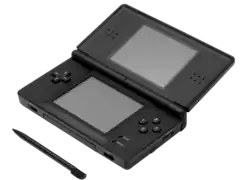Stylus (computing)
In computing, a stylus (or stylus pen) is a small pen-shaped instrument whose tip position on a computer monitor can be detected. It is used to draw, or make selections by tapping. While devices with touchscreens such as newer computers, mobile devices (smartphones and personal digital assistants[1]), game consoles,[2] and graphics tablets[1] can usually be operated with a fingertip, a stylus provides more accurate and controllable input.[3] The stylus has the same function as a mouse or touchpad as a pointing device; its use is commonly called pen computing.

History
The first use of a stylus in a computing device was the Styalator, demonstrated by Tom Dimond in 1957.[4][5]
Types
Different types of stylus are used for graphics tablets, and resistive and capacitive touchscreens. Capacitive screens are very widely used on smart phones and multi-touch surfaces, where simultaneous use of several fingers is detected; a stylus cannot replicate this.[6]
Capacitive
Capacitive (also called passive) styluses emulate a finger by using a tip made of rubber or conductive foam; or metal such as copper. They do not need to be powered and can be used on any multi-touch surface that a finger can be used, typically capacitive screens that are common in smart phones and tablet computers. Stylus tips made of rubber or foam are often large so it's difficult to get precise notes or drawings.
Capacitive styluses work by distorting the screen’s electrostatic field.[7] Screens that receive input from a capacitive stylus (as well as human fingers) can't register pressure applied by the pen; tilting of the pen; and can't distinguish between a capacitive stylus, your finger, or a resting palm as input - it will register all of these touches as marks on the screen.
Capacitive styluses are made of a conductive material (typically as a metal rod or barrel) to transmit electrical charge between your hand and a rubber/foam[8] or metal tip such as copper. Being free of any digital components, capacitive styluses can be cost effective to manufacture. DIY capacitive styluses can also be made with materials found at home.[9]
Capacitive styluses tend to work on any multi-touch surface that accepts input from a finger.
Active
See also Active pen, Digital pen
Active (also called digital[1]) styluses include digital components or circuitry inside the pen that communicates with a digitizer on the touch device. This communication allows for advanced features like pressure sensitivity; tilt; programmable buttons; palm detection; eraser tips; memorizing settings and writing data transmission. In order for an active stylus to function, its digital component protocol must match the digitizer technology in the touch screen it is interacting with. Active styluses are powered by a removable or chargeable battery, or operate passively by inductance.
Active styluses use different protocols by different manufacturers in order to communicate with the digitizer of a graphic tablet or multi-touch device. The digital protocol of the pen must match the device digitizer, otherwise input from the pen will not register on the device.
These types of active stylus protocols available are:
- Microsoft Pen Protocol (MPP) (formerly N-trig)
- Wacom AES 1.0 and 2.0
- Wacom EMR
- Univeral Stylus Initiative (USI)
- Apple Pencil Active Projected Capacitive (APC)
- Bluetooth
Examples of active styluses:
- Microsoft Surface Pen
- Samsung S-Pen
- Google Pixelbook Pen
- Apple Pencil
Performance
A stylus' performance is measured by these four characteristics:[10]
- Comfort
- Resistance
- Balance and weight
- Precision:
- Responsiveness & speed
- Jitter
- Tilt
- Levels of pressure
- Palm rejection or detection,[11] which prevents a touch device from registering or marking the screen when a hand or palm is resting on the screen surface, relies on a combination of technology in the stylus, the OS software and the screen digitizer technology, to work effectively.
Gallery
 A smartphone being operated with a stylus.
A smartphone being operated with a stylus..jpg.webp) Samsung Galaxy Note series of smartphones come with an integrated stylus called S-Pen
Samsung Galaxy Note series of smartphones come with an integrated stylus called S-Pen A Nintendo DS with its stylus.
A Nintendo DS with its stylus.
References
- Shelly, Gary B.; Misty E. Vermaat (2009). Discovering Computers: Fundamentals. Cengage Learning. ISBN 978-0-495-80638-7. Archived from the original on 15 February 2017. Retrieved 3 November 2009.
- "Giz Explains: The Magic Behind Touchscreens". Gizmodo. 13 August 2008. Archived from the original on 26 November 2009. Retrieved 3 November 2009.
- Charles Arthur (20 October 2009). "Windows Mobile: where's the love? And where's the sales figure?". The Guardian. London. Archived from the original on 11 October 2016.
- Dimond, Tom (1957-12-01). "Devices for reading handwritten characters". Proceedings of Eastern Joint Computer Conference. pp. 232–237. Archived from the original on 2008-07-05. Retrieved 2008-08-23.
- Dimond, T. L. (1958). "Devices for Reading Handwritten Characters". December 9–13, 1957 Eastern Joint Computer Conference: Computers with Deadlines to Meet. Association for Computing Machinery: 232–237. doi:10.1145/1457720.1457765. S2CID 17961928.
- Brandon, John (15 December 2008). "The Age of Touch Computing: A Complete Guide". PC World. Archived from the original on 27 December 2017.
- Kazmeyer, Milton (September 28, 2018). "How Does a Stylus Pen Work?". Techwalla. Retrieved June 1, 2020.
- "The Science Behind Capacitive Styluses". Nelson-Miller, Inc. 2019-07-15. Retrieved 2020-06-01.
- Bell, Donald. "How to make a capacitive stylus (photos)". CNET. Retrieved 2020-06-01.
- "The Best Stylus for Your iPad for 2020". The New York Times. 2019-11-18. ISSN 0362-4331. Retrieved 2020-06-01.
- "What is palm rejection?".
External links
| Wikimedia Commons has media related to Stylus. |
- Annotated Bibliography of References to Pen Computing, Touchscreens, and Tablets
- Notes on the History of Pen-based Computing on YouTube
(p)
